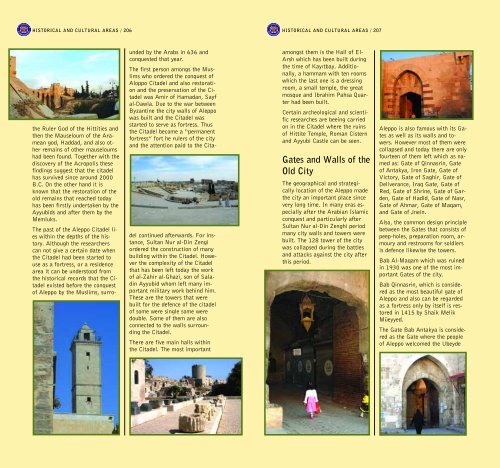You also want an ePaper? Increase the reach of your titles
YUMPU automatically turns print PDFs into web optimized ePapers that Google loves.
HISTORICAL AND CULTURAL AREAS / 206<br />
the Ruler God of the Hittities and<br />
then the Mauseloum of the Aramean<br />
god, Haddad, and also other<br />
remains of other mauseloums<br />
had been found. Together with the<br />
discovery of the Acropolis these<br />
findings suggest that the citadel<br />
has survived since around 2000<br />
B.C. On the other hand it is<br />
known that the restoration of the<br />
old remains that reached today<br />
has been firstly undertaken by the<br />
Ayyubids and after them by the<br />
Memluks.<br />
The past of the Aleppo Citadel lies<br />
within the depths of the history.<br />
Although the researchers<br />
can not give a certain date when<br />
the Citadel had been started to<br />
use as a <strong>for</strong>tress, or a residence<br />
area it can be understood from<br />
the historical records that the Citadel<br />
existed be<strong>for</strong>e the conquest<br />
of Aleppo by the Muslims, surro-<br />
unded by the Arabs in 636 and<br />
conquested that year.<br />
The first person amongs the Muslims<br />
who ordered the conquest of<br />
Aloppo Citadel and also restoration<br />
and the preservation of the Citadel<br />
was Amir of Hamadan, Sayf<br />
al-Dawla. Due to the war between<br />
Byzantine the city walls of Aleppo<br />
was built and the Citadel was<br />
started to serve as <strong>for</strong>tress. Thus<br />
the Citadel become a “permanent<br />
<strong>for</strong>tress” <strong>for</strong>t he rulers of the city<br />
and the attention paid to the Cita-<br />
del continued afterwards. For instance,<br />
Sultan Nur al-Din Zengi<br />
ordered the construction of many<br />
building within the Citadel. However<br />
the complexity of the Citadel<br />
that has been left today the work<br />
of al-Zahir al-Ghazi, son of Saladin<br />
Ayyubid whom left many important<br />
military work behind him.<br />
These are the towers that were<br />
built <strong>for</strong> the defence of the citadel<br />
of some were single some were<br />
double. Some of them are also<br />
connected to the walls surrounding<br />
the Citadel.<br />
There are five main halls within<br />
the Citadel. The most important<br />
HISTORICAL AND CULTURAL AREAS / 207<br />
amongst them is the Hall of El-<br />
Arsh which has been built during<br />
the time of Kay›tbay. Additionally,<br />
a hammam with ten rooms<br />
which the last one is a dressing<br />
room, a small temple, the great<br />
mosque and Ibrahim Pahsa Quarter<br />
had been built.<br />
Certain archeological and scientific<br />
researches are beeing carried<br />
on in the Citadel where the ruins<br />
of Hittite Temple, Roman Cistern<br />
and Ayyubi Castle can be seen.<br />
Gates and Walls of the<br />
Old City<br />
The geographical and strategically<br />
location of the Aleppo made<br />
the city an important place since<br />
very long time. In many eras especially<br />
after the Arabian Islamic<br />
conquest and particularly after<br />
Sultan Nur al-Din Zenghi period<br />
many city walls and towers were<br />
built. The 128 tower of the city<br />
was collapsed during the battles<br />
and attacks against the city after<br />
this period.<br />
Aleppo is also famous with its Gates<br />
as well as its walls and towers.<br />
However most of them were<br />
collapsed and today there are only<br />
fourteen of them left which as named<br />
as: Gate of Qinnasrin, Gate<br />
of Antakya, Iron Gate, Gate of<br />
Victory, Gate of Saghir, Gate of<br />
Deliverance, Iraq Gate, Gate of<br />
Red, Gate of Shrine, Gate of Garden,<br />
Gate of Hadid, Gate of Nasr,<br />
Gate of Ahmar, Gate of Maqam,<br />
and Gate of Jnein.<br />
Also, the common design principle<br />
between the Gates that consists of<br />
peep-holes, preparation room, armoury<br />
and restrooms <strong>for</strong> soldiers<br />
is defence likewise the towers.<br />
Bab Al-Maqam which was ruined<br />
in 1930 was one of the most important<br />
Gates of the city.<br />
Bab Qinnasrin, which is considered<br />
as the most beautiful gate of<br />
Aleppo and also can be regarded<br />
as a <strong>for</strong>tress only by itself is restored<br />
in 1415 by Shaik Melik<br />
Müeyyed.<br />
The Gate Bab Antakya is considered<br />
as the Gate where the people<br />
of Aleppo welcomed the Ubeyde


